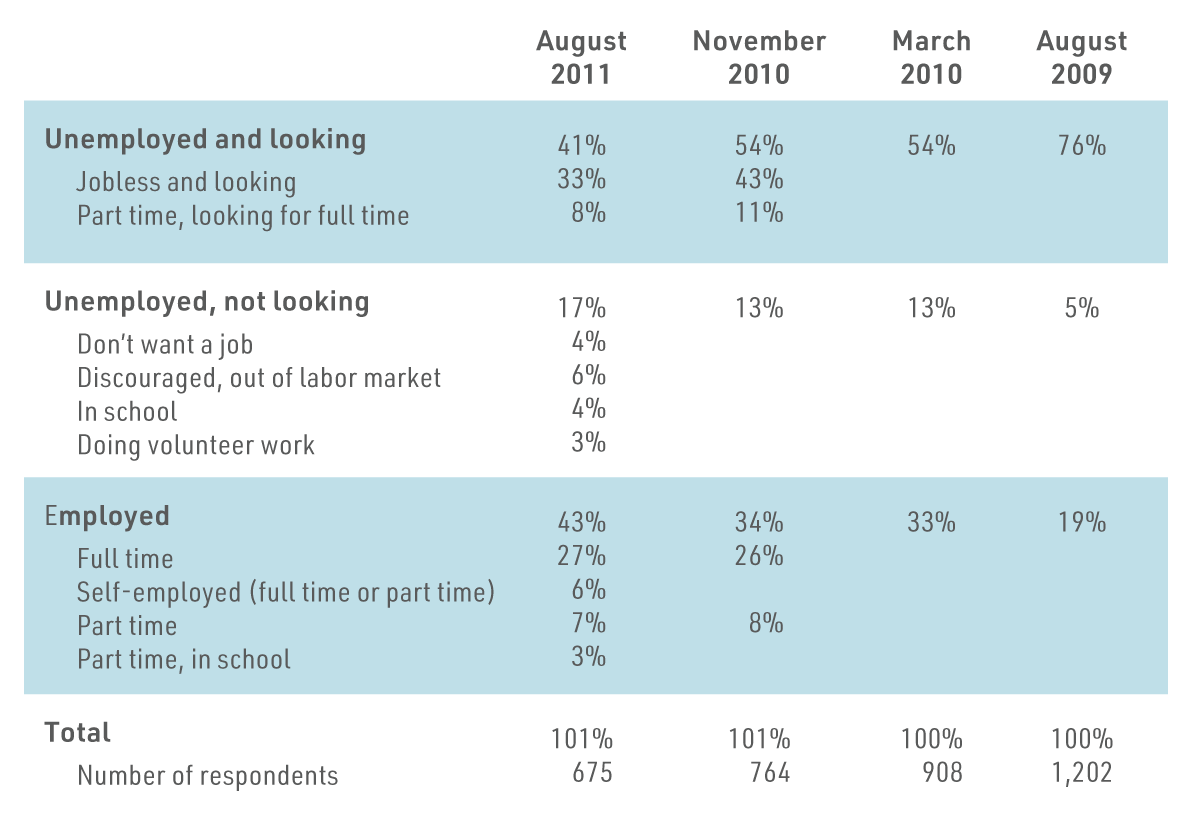Work Trends | Chapter 5
The Misery of Long-Term Unemployment: The Great Recession
A groundbreaking longitudinal panel study of American workers experiencing unemployment and long-term unemployment (workers looking for work for at least six months) during and after the Great Recession. Heldrich Center researchers conducted four surveys asking workers about their unemployment and reemployment experiences from 2008 to 2011. This series went on to win the 2013 American Association for Public Opinion Research Policy Impact Award.
The Heldrich Center surveyed a national random sample of unemployed American workers who lost a job during the Great Recession in four phases:
- The Center conducted a random probability sample of 1,202 respondents from August 6 to 12, 2009. Eligibility was defined as those who had been unemployed at some point in the prior 12 months (between September 2008 and August 2009).
- Researchers successfully reinterviewed 908 respondents (76% of the original sample) from March 10 to 23, 2010.
- The Center followed up from November 5 to 28, 2010, successfully completing questionnaires with 764 respondents (64% of the original sample).
- From July 21 to August, 10, 2011, the Center successfully reinterviewed 675 respondents, or 56% of the initial sample.
Studies
Work Trends Unemployment Panel at the Roper Center for Public Opinion Research
No End in Sight: The Agony of Prolonged Unemployment
The Shattered American Dream: Unemployed Workers Lose Ground, Hope, and Faith in their Futures
Out of Work and Losing Hope: The Misery and Bleak Expectations of American Workers
Key Findings
Half of the unemployed workers interviewed in July/August 2011 were unable to find a full-time job for more than two years. Most were jobless and looking, while others worked part time while looking for full-time work or stopped looking entirely. This table presents the employment status of respondents for all four waves, including why some were no longer looking for work.
In August 2009, 76% of the sample was unemployed and looking for a job and 5% was unemployed but not looking for work. In July/August 2011, while 41% were unemployed and looking for their next job, 17% said they were not working but no longer searching for a job.
Among the respondents who obtained new jobs, those jobs did not come quickly, were temporary, or paid less:
- Just one quarter found new employment within two months.
- A large number (43%) of these new jobs were not permanent.
- For many, taking a new job meant changing fields. This increasingly became the case as time went by.
- There was a decided financial cost to taking new jobs. Just over half reported taking a pay cut to accept their new positions.
- Unemployed Americans became increasingly convinced that the conditions that plagued them — and the economy overall — would persist.
- The percentage saying the U.S. economy was experiencing fundamental and lasting changes grew from 52% in August 2009 to 71% in July/August 2011.
- Despite the formal “end” of the recession in June 2009, just 29% said the economy was in a temporary downturn, compared to 48% who thought this way in August 2009.
By the Numbers
Of the respondents who were unemployed for more than two years:
%
sold some of their possessions to make ends meet
%
borrowed money from family and friends, other than adult children
%
cut back on medical treatment or doctor’s visits
Voices of Workers
What do you think will be the most significant long-lasting change of the recession?
Media Coverage
Snapshot: Unemployment Insurance Benefits Increase Job-Search Activities – Economic Policy Institute
Unemployment Not Doing the Job? – Politico
As Unemployed Lose Benefits, More Seek Welfare Benefits – The Philadelphia Inquirer
Living Without Work: The Long-Term Unemployed – NPR
What Recovery? For the Unemployed, the Pain Gets Worse – The New York Times
Other Topics Covered
Older workers
Unemployment Insurance
What government should be doing to help the unemployed
Related Studies
The Anxious American Worker
Conducted by telephone from May 14 to 25, 2008, with a scientifically selected random sample of 1,000 U.S. residents, 587 of whom were in the labor force.


